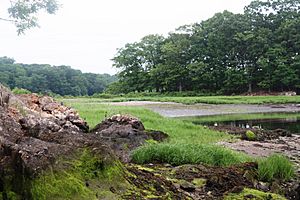Marshlands Conservancy facts for kids
Quick facts for kids Marshlands Conservancy |
|
|---|---|
 |
|
| Location | 220 Boston Post Road, Rye, New York |
| Nearest city | Rye, New York |
| Area | 147 acres |
| Created | 1966;1977 |
| Operated by | Westchester County Parks |
| Open | All year |
Marshlands Conservancy is a special nature preserve in Rye, New York. It covers 147 acres and is managed by Westchester County Parks. This amazing place has many different natural areas, like ponds, creeks, a big meadow, and a unique salt marsh. It borders Long Island Sound and is a great spot to see wildlife and enjoy nature.
Marshlands Conservancy is part of the Boston Post Road Historic District. It is also known as an Important Bird Area because so many different birds visit or live there.
Contents
History of the Land
Ancient Discoveries
Archaeologists have found signs that people lived at Marshlands Conservancy thousands of years ago. These findings show that ancient groups, like the Paleo-Indians, used this land. They left behind tools and other items from the Archaic and Woodland periods.
How the Park Was Created
Before it became a park, this land was part of two large estates. One belonged to John Jay, a Founding Father of the United States. The other was owned by the Parsons family.
The nature preserve was first called the Devereux Reservation. It was created through two gifts of land. The first gift of 120 acres came from Zilph Palmer Devereux in 1966.
In 1972, a small shelter was built, and the park officially opened as Marshlands Park. A special group of volunteers was formed to help manage the land.
Another 17 acres were given by Fanny Wickes Parsons in 1977. She asked that no garages or boat docks be built on the land.
In 1997, the 147-acre property was renamed Marshlands Conservancy. It was set aside as a "passive parkland." This means it is protected for nature and wildlife, and people can only use it for quiet activities. A "Friends" group was also started to help with tours and raise money for the park.
What You Can See and Do
Archaeological Importance
Marshlands Conservancy is very important for archaeology. In 1985, a report confirmed its high archaeological value. Many stone tools, including 88 "fishtail points," have been found here. These tools suggest that ancient people, known as the Orient culture, had camps at this site.
Salt Marsh and Tidal Flats
The preserve has a special salt marsh and tidal flats. These are rare ecosystems in New York State. A salt marsh is a coastal wetland that is flooded by ocean tides. Tidal flats are muddy or sandy areas that are covered and uncovered by the tides. They are home to unique plants and animals.
Woodland Trails and Old Ruins
Marshlands Conservancy has two main walking trails. The longest one is about 2.8 miles. You can enjoy walking, hiking, and watching birds here. To protect the wildlife, dogs and bikes are not allowed.
Along the trails, you can find the ruins of an old summer home. All that is left are a chimney and stone foundation. It's a cool reminder of the past.
Streams and Waterways
Two streams, called East Stream and West Creek, flow through Marshlands Conservancy. These waterways are important for the park's animals and plants.
Animals of Marshlands
Marshlands Conservancy is home to many different creatures. You might see horseshoe crabs, foxes, and even coyotes. Many visitors come to study the saltwater life.
Birds
The land was given to create a safe place for birds, especially waterfowl and birds that migrate. Over 230 different kinds of birds have been seen here. Some rare birds like the Black rail and American Avocet have been spotted.
Fish and Shellfish
In the waters of Marshlands, you can find marine life like pipefish, small crabs, and killifish. These small creatures are an important part of the food chain.
Mammals
Many mammals live at the conservancy. You might see deer, foxes, coyotes, rabbits, and groundhogs. They all have their homes and find food within the park.
Plants of Marshlands
Native Plants
The conservancy is home to many native plants. These are plants that naturally grow in the area. Some examples found here include lopseed, marshmallow, and butterfly weed.
Invasive Species
Like many natural areas, Marshlands is facing challenges from invasive species. These are plants or animals that are not native to the area and can harm the local ecosystem. They grow very fast and can take over.
Some invasive plants found here include mugwort, Japanese knotweed, and Norway maples. Asian shore crabs are also an invasive species that have caused problems for native snails like the common periwinkle.
Images for kids





